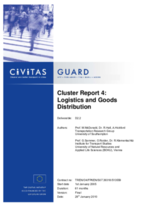Planning for alternative transport modes
Summary
Creating safer and more convenient facilities for cyclists and pedestrians is a sustainable way of reducing car use and congestion.
Implementing sustainable mobility
Research carried out in connection with Preston’s TravelSmart project suggested that cycling had the greatest potential of any mode to replace car journeys. It is more flexible than public transport, offers comparable journey times to the car for short journeys, and enables people to go further than on foot.
However, the traffic management system in Preston city centre represented something of a barrier to bike use and Preston had a high accident rate for cyclists. Prior to measure implementation, cycle use in Preston was declining and was low by European standards.
The general objectives were therefore to:
- promote walking and cycling by developing new strategies;
- facilitate the use of transport resources with lower pollution emissions;
- reduce dependency on the private car;
- improve the integration of walking, cycling and other sustainable modes; and
- make sustainable choices available to people with restricted mobility.
Progress
A pedestrian/cycling audit of the city centre and other important routes was carried out in January 2006. Local communities were involved in audits of the area, using the “Living Streets” approach.
Public consultation meetings were held (in March and September 2006) on draft strategies for improving conditions for pedestrians in the city.
A strategic plan for the development of alternative transport modes was then developed and the concept design was approved by the local authority in December 2006.
Outcomes
Improvements to routes, infrastructure and information provision for cyclists in Preston resulted in an increase in cycle use in the area during the CIVITAS project. However, an analysis of cycling accidents suggested a continuing need to improve facilities for cyclists on main roads and to develop a network of cycle routes.
This fact sheet has been updated by a third party on the basis of available information (not by the city itself), therefore we do not guarantee any data with respect to their content, completeness or up-to-dateness.








